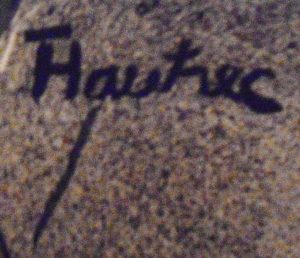Henri de Toulouse-Lautrec (1864-1901). Le Divan Japonais. Paris, published by Edouard Fournier, printed by Edward Ancourt, [January 1893]. Pencil, brush and crachis lithography with four-color carry-on frame, linestone in olive green and colored stones in black, yellow and red. Dimension 80,3 x 61,2 cm. Ancient canvas.
Commandée à Toulouse-Lautrec par Jehan Sarrazin, le directeur du « Divan japonais », café-concert qui accueillait les spectateurs au 75 rue des Martyrs, à Montmartre, dans un décor japonisant de lanternes et de faux bambous, l’affiche réunit deux modèles fétiches de l’artiste, la chanteuse Yvette Guilbert, dont la tête est coupée, reconnaissable à ses longs gants noirs, et la danseuse de cancan Jane Avril figurant pour la première fois sur une estampe de Lautrec qui lui consacre alors plusieurs peintures (Jane Avril au Jardin de Paris, 1893 ; La Troupe de Mlle Églantine, 1896 ; Jane Avril, 1899). Au premier plan, élégante et majestueuse, elle assiste au spectacle, with, à ses côtés, le critique musical et littéraire Édouard Dujardin, deux amis de l’artiste qui s’inspire ici de L’Orchestre de l’Opéra de Degas (musée d’Orsay, Paris).
Une de ses créations les plus brillantes, emblématique de son art lithographique, tout de contrastes et d’effets vibratoires entre zones noires, aplats de couleurs au spectre réduit et surfaces modulées en « crachis », cette projection sur la pierre lithographique pour donner plus de variété aux couleurs au moyen d’une brosse frottée de taches d’encres sous forme de gouttelettes.
L’intensité du noir de la robe de Jane Avril et des chapeaux fait ressortir la luminosité de la scène, en jaune, sur laquelle chante Yvette Guilbert, en arrière-plan. Entre les deux, la silhouette grise des manches dressés et sinueux des contrebasses et des bras du chef d’orchestre crée une impression d’espace entre le spectacle et le public. Seule tache de couleur vive, la rousseur de la chevelure de Jane Avril focalise l’attention. Cernée par un trait vigoureux, chaque figure se détache nettement de l’ensemble, mais participe d’une composition audacieuse où l’influence de l’estampe japonaise est manifeste. (cf. Musée Toulouse Lautrec, Albi et Musée de Strasbourg).
The Divan Japonais, a cabaret in Montmartre, an artists’ quarter in Paris, was newly redecorated in 1893 with fashionable Japanese motifs and lanterns. Its owner, Édouard Fournier, commissioned this poster (31,6 x 24,1 in) — depicting singers, dancers, and patrons — from Toulouse-Lautrec to attract customers to the opening of his nightclub. In the immediate foreground, Toulouse-Lautrec depicts two of his good friends in the audience: on the right, Édouard Dujardin, an art critic and founder of the literary journal Revue wagnérienne, and, at the center, the famous cancan dancer Jane Avril, whose elegant black silhouette dominates the scene. In the background, another well-known entertainer of the period, the singer Yvette Guilbert, performs on stage. Although her head is abruptly cropped in this composition—reflecting the influence of photography and Japanese prints—Guilbert was immediately known to contemporary patrons by the dramatic gesture of her signature long black gloves.
Lithographed posters proliferated during the 1890s due to technical advances in color printing and the relaxation of laws restricting the placement of posters. Dance halls, café-concerts, and festive street life invigorated nighttime activities. Toulouse-Lautrec’s brilliant posters, made as advertisements, captured the vibrant appeal of the prosperous Belle Époque. He was to become one of the greatest printmakers of all time, and played a major part in elevating the popular medium of lithography to the status of fine art. One of his unrivalled techniques was the splatter technique (known as crachis), which is seen here especially in some of the darker areas, such as the man’s trousers. The deep blacks and strong blocks of colours also signal his exceptional skills. (cf. The Museum of Modern Art, revised 2004, originally published 1999, p. 41 and Barber Institute of fine arts, University of Birmingham).
Delteil, 341 ; Wittrock, P11.
Very good general condition despite skilful restorations.
One of Toulouse-Lautrec’s major works.
18 000 €


